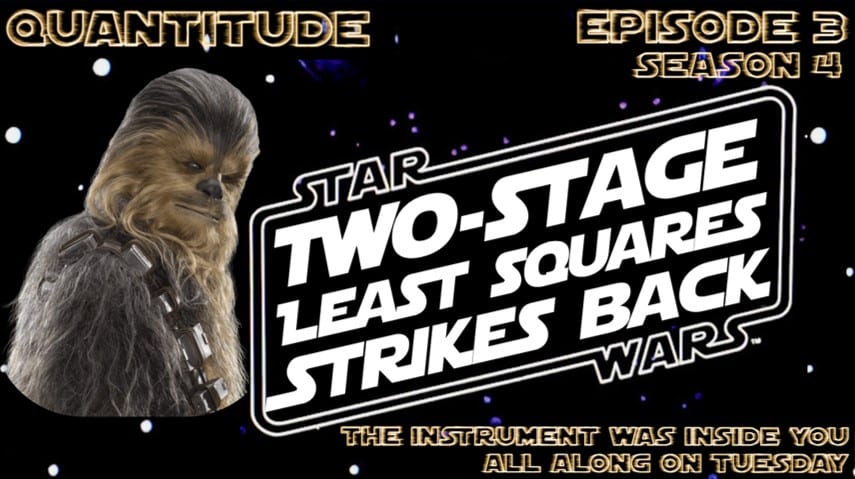In this week’s episode Greg and Patrick explore the often neglected method of two stage least squares; they take a walk down memory lane to explore its origins and then drag it kicking and screaming into the 21st century for much promising use within the latent variable model. Along the way they also discuss magic dishwashers, being under-estimated, blind pigs & truffles, Sadie Hawkins, intellectual spinning hook kicks, Fisher’s eight-pack abs, the fine print, Winston Churchill vs. Chewbacca, Guinea pigs, Mrs. Lincoln, butter snacks, and snipe hunts.
Lightly Edited Transcript
We provide a lightly-edited and obviously imperfect audio transcript of the episode available here. This is not an exact representation of the audio, but does provide a searchable document with identified speakers and associated time stamps.
Related Episodes
S4E01 Ordinary Least Squares: Back Where It All Began
S4E02 Underachievers, Overachievers, & Maximum Likelihood Estimation
S2E18 Regression — Like That Old High School Friend You’ve Outgrown
Suggested Readings
Anderson, T. W. (2005). Origins of the limited information maximum likelihood and two-stage least squares estimators. Journal of Econometrics, 127(1), 1-16.
Basmann, R. (1957). A generalized classical method of linear estimation of coefficients in a structural equation. Econometrica, 25, 77–83.
Bollen, K. A. (1995). Structural equation models that are nonlinear in latent variables: A least-squares estimator. Sociological Methodology, 25, 223–251.
Bollen, K. A. (1996). An alternative 2sls estimator for latent variable models. Psychometrika, 61, 109–121.
Bollen, K. A. (2012). Instrumental variables in sociology and the social sciences. Annual Review of Sociology, 38, 37–72.
Bollen, K. A., Fisher, Z., & Gates, K. M. (2018). Robustness conditions for MIIV-2SLS when the latent variable or measurement model is structurally misspecified. Structural Equation Modeling.
Bollen, K., A., Kirby, J., B., Curran, P., J., Paxton, P., M., & Chen, F. (2007). Latent variable models under misspecification: two-stage least squares (2SLS) and maximum likelihood (ML) estimators. Sociological Methods & Research, 36, 48–86.
Bollen, K. A., & Maydeu-Olivares, A. (2007). A polychoric instrumental variable (PIV) estimator for structural equation models with categorical variables. Psychometrika, 72, 309–326.
Fisher, Z. F., Bollen, K. A., Gates, K., & Ronkk € o, M. (2017). MIIVsem: Model implied instrumental variable (MIIV) estimation of structural equation models. R package version 0.5.2.
James, L. R., & Singh, B. K. (1978). An introduction to the logic, assumptions, and basic analytic procedures of two-stage least squares. Psychological Bulletin, 85(5), 1104.
Theil, H. (1953a). Repeated least-squares applied to a complete equation systems. Mimeo. The Hague, Netherlands: Central Planning Bureau.
Theil, H. (1953b). Estimation and simultaneous correlation in complete equation systems. Mimeo. The Hague, Netherlands: Central Planning Bureau.
Wright, P. G. (1928). The tariff on animal and vegetable oils. New York: Macmillan.
Wright, S. (1925). Corn and hog correlations. United States Department of Agriculture Bulletin, 1300, 1–60.

